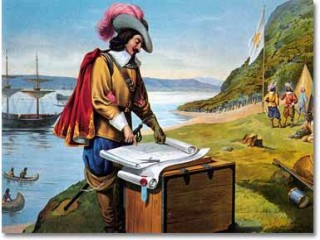
Etienne Brule biography
Date of birth : -
Date of death : -
Birthplace : Champigny-sur-Marne, France
Nationality : French
Category : Historian personalities
Last modified : 2011-04-16
Credited as : Explorer, Discoveries and Explorations,
Étienne Brûlé (ca. 1592-1633) was a French explorer in North America. He was the first European to voyage through the Great Lakes and the Susquehanna Valley.
Etienne Brûlé was born reputedly at Champigny-sur-Marne. When, in 1608, Samuel de Champlain went to the New World and founded a trading post at Quebec, Brûlé was probably a member of that expedition. In 1610 Brûlé voyaged west with a band of Algonquians to learn their language, a vital necessity in the fur trade. Where Brûlé traveled is not known, but when he returned to Quebec the following year, Champlain was well pleased with Brûlé's knowledge of the Indian country and the Algonquin language. Shortly afterward Brûlé returned to the west; and when Champlain, in 1615, assisted the Hurons in a campaign against the Onondagas near presentday Syracuse, N.Y., Brûlé volunteered to accompany a Huron delegation across the enemy's country to enlist the aid of the Susquehannas. The reinforcements the delegation brought arrived too late, for Champlain and the Hurons had been defeated and forced to retreat.
Brûlé spent the following year or more with the Susquehanna tribe and apparently traveled down the river bearing their name to Chesapeake Bay, the first European to traverse that part of present-day Pennsylvania. According to the account of his journey that Brûlé later gave Champlain, on the way back he was captured by the Senecas, tortured, and subsequently released and sent to Quebec to assist in concluding a peace treaty and establishing trade relations between the Iroquois and the French. In 1621 or 1622 Brûlé returned to the west and appears to have voyaged to Lake Superior. There is some evidence to indicate that he went as far as the site of present-day Duluth.
By this time Brûlé appears to have been more attuned to the permissive Indian way of life than to that of the more puritanical French. The missionaries complained that he was leading a scandalous life and making their efforts to impose Christian morals and religious beliefs on the Native Americans more difficult. In 1629 Brûlé threw in his lot with the English trader Sir David Kirke, who forced Champlain to surrender Quebec. In 1632 Canada was returned to France, but Brûlé was not brought to account. He had returned to the west, where in 1633 he was killed by the Hurons under obscure circumstances.
Brûlé left no record of his travels, and his activities can be gleaned only from passing references in the accounts of others. He spent most of his active life with Native Americans and was assimilated by them. According to the account of the missionary Gabriel Sagard, Brûlé was eaten by his Huron murderers; if indeed this is true, then no one could have been more completely assimilated than he was.
The most reliable account of Brûlé is Consul Willshire Butterfield, History of Brûlé's Discoveries and Explorations, 1610-1626 (1898). J. H. Cranston, Étienne Brûlé Immortal Scoundrel (1949), is romanticized. Brûlé figures in John Bartlet Brebner, The Explorers of North America, 1492-1806 (1933), and in Morris Bishop, Champlain: The Life of Fortitude (1948).

















